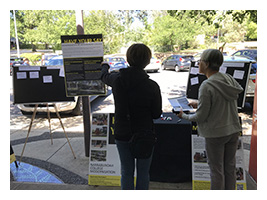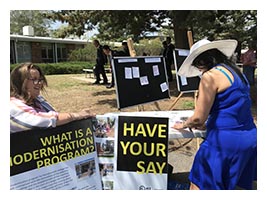Modernisation of Narrabundah College – Have Your Say
Community Consultation
A school modernisation process has commenced at Narrabundah College to improve our school and facilities which allow students and teachers to thrive. This modernisation process started in 2018 with the removal of asbestos-affected buildings (Blocks B, C and D) and the construction of a temporary learning village. The next step of the modernisation process has commenced, with planning underway for the College’s medium and long-term future, and the community is invited to help us shape what that might look like.
The ACT Government conducted a six-week community conversation to seek feedback from the school community, key stakeholders, local schools and the broader Canberra community about modernising Narrabundah College. Thank you to everyone who contributed to the community engagement program which concluded on Sunday 24 November 2019.
The consultation program received over 1000 pieces of feedback received from a variety of stakeholder groups including students, parents, teachers, alumni, community members and organisations. All up, there were 29 consultation activities undertaken as part of this engagement program including workshops, pop-up feedback sessions, one-on-one conversations, meetings, future student workshops and an online scrapbook. This great feedback will now help inform a feasibility study and some preliminary concept designs for how the future campus might be. Whilst this engagement program has now concluded, the conversation will continue during various stages of the modernisation journey. If you would like more information about the Modernisation Program or would like to contribute some further ideas, contact the college on: (02) 6142 3200 or info@narrabundahc.act.edu.au.
Feedback was sought on the following themes:
Education future
Education is changing all around the world. The way students are taught and the way they learn is shaping learning spaces. How will changes to pedagogy, curriculum and technology influence the way that learning spaces are shaped and used at Narrabundah College in the future? How can physical spaces enhance the access, agency, voice and diversity of students in the College in the years to come?
Community connection and partnerships
Narrabundah College has been part of the local community since 1974. What role does the College currently fill in the community? What potential roles could it fill in the future? What connections, partnerships and opportunities for collaboration might be possible? How could new physical spaces increase these connections and partnerships? How can the community utilise the facilities for their use out of school hours?
Facilities and amenities
In looking towards the future, it is important to consider all the different users of the College space and considering what they will need. What are the general, specialist and vocational facilities required at Narrabundah College? How would you ensure that the College provides for potential increases to student numbers? How would you make use of outdoor spaces? What size should new buildings be? What would you like it to look like?
Identity of Narrabundah College
The students, staff, community and alumni of Narrabundah College feel a strong connection to the College. What is it that makes these connections so strong? What are the qualities that make Narrabundah College unique and what needs to be maintained, preserved and enhanced no matter what, during the next phase of the College’s development?


Frequently asked questions
The feedback received will be used to:
- Identify what is important to the community;
- inform a feasibility study that will explore options to modernise Narrabundah College; and
- It will also be used to inform architectural concept planning.
There is no specific timeframe in place. However, modernisation of the College has already commenced with the demolition of the asbestos affected buildings and the establishment of the Learning Village. This next step is the start of a longer-term project which may be undertaken in stages over the coming years. However, feedback from the community will help shape the scope and duration of the modernisation of the College.
The ACT Government is committed to ensuring that Narrabundah College can continue to operate at its current site and does not plan to relocate the College.
The quality and standard of learning at Narrabundah College will not be impacted by the modernisation process. The safety and learning environment for students and staff is very important to the ACT Government.
The project is currently funded to undertake this community conversation, the feasibility study and some initial concept planning work. The feasibility study will determine what future funding is required to progress the modernisation process.
The first stage of the modernisation of the College was completed with the installation of the 22 new transportable buildings on the oval, following the demolition of the three asbestos-affected double-storey buildings - Blocks B, C & D (located at the northern end of the college site). The Learning Village provides contemporary learning and teaching spaces, as well as break out areas for students, and a range of specialist learning spaces to support the high-quality teaching and learning we have come to know from Narrabundah College.
These new spaces for the Science, Arts, English, Philosophy, History, Politics, Learning Support and French Baccalaureate faculties, will serve the students of this school community well, providing them with a comfortable, bright and spacious learning environment or ‘Learning Village’ as it’s affectionately referred to. Students and staff commenced teaching and learning in these contemporary classrooms at the start of term 3, 2018.
